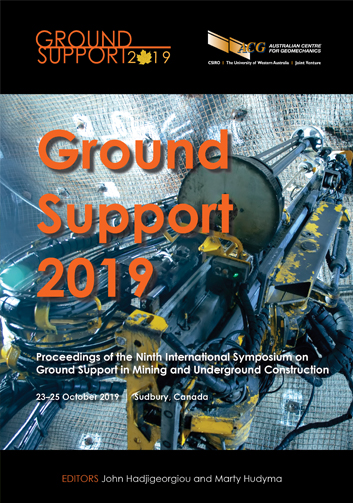Development of a new cementitious grout for permafrost conditions

|
Authors: Reny, S; Pena Cruz, J; Clements, W |
DOI https://doi.org/10.36487/ACG_rep/1925_38_Reny
Cite As:
Reny, S, Pena Cruz, J & Clements, W 2019, 'Development of a new cementitious grout for permafrost conditions', in J Hadjigeorgiou & M Hudyma (eds), Ground Support 2019: Proceedings of the Ninth International Symposium on Ground Support in Mining and Underground Construction, Australian Centre for Geomechanics, Perth, pp. 533-544, https://doi.org/10.36487/ACG_rep/1925_38_Reny
Abstract:
Nowadays underground mining in very cold climates above the 60th parallel is becoming more and more common. Furthermore, automatisation of the ground control process is also now a key in mining efficiencies. This new era brings new technical challenges for methods and products to perform under such cold temperatures. The grouted portion of the cable bolt system is critical to the success of the cable installation and ensure proper ground support. Normal Portland based cement will not properly hydrate in temperatures below the freezing point. King Packaged Materials Company (King) has developed a grout technology that has been adapted for several permafrost grouting applications including grout for pile construction of surface infrastructure, fluid consistency neat grout for cable bolting using the breather tube method and a thick consistency neat grout for an automatic cable bolter using the grout and insert method. This paper describes the mixing, placing and curing conditions under which this cementitious grout must be placed in the various applications used so far. Secondly it covers the test programs conducted under laboratory conditions to demonstrate performance of the new developed cementitious grout under such cold conditions. The third portion of this paper provides information on the in situ test programs used for each application. Finally, it reviews the different test results obtained under the different testing conditions. The intent of this paper is to demonstrate that installation of cement grouted cable can be achieved using several different applications methods under permafrost conditions.
Keywords: permafrost, grout, cable bolting, cable bolter, freezing, ground control, automatisation
References:
ASTM International 2018, Standard Test Method for Compressive Strength of Cylindrical Concrete Specimens (ASTM C39/C39M), ASTM International, West Conshohocken.
Dufour, JF & Beaupré, D 1999, ‘Development of Shotcrete Mixes to Perform in Permafrost’, Proceedings of the Third International Symposium on Sprayed Concrete: Modern Use of Wet Sprayed Concrete for Underground Support, Norway, pp. 196–207.
Hutchinson, DJ & Diederichs, MS 1996, Cablebolting in Underground Mines, Bitech, Vancouver.
Marek, A, Thorley, S, Dawson, L & Pickering, R 2012, ‘Mechanized bolting-on-board drilling automation and a change in the support regim in low-profile mechanized mining’, Proceedings of the Fifth International Platinum Conference – A Catalyst for Change, The Southern African Institute of Mining and Metallurgy, pp. 49–64.
© Copyright 2025, Australian Centre for Geomechanics (ACG), The University of Western Australia. All rights reserved.
View copyright/legal information
Please direct any queries or error reports to repository-acg@uwa.edu.au
View copyright/legal information
Please direct any queries or error reports to repository-acg@uwa.edu.au